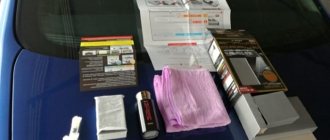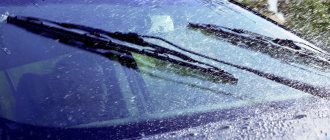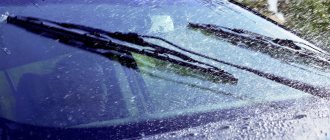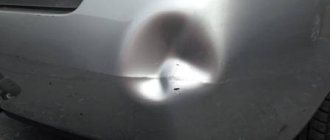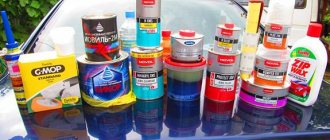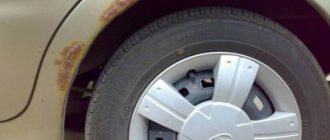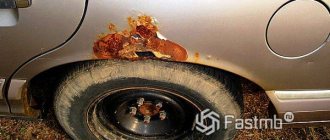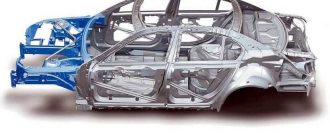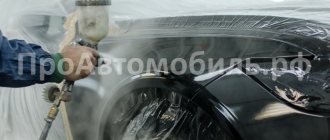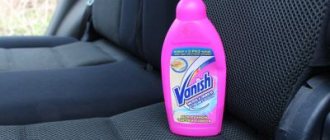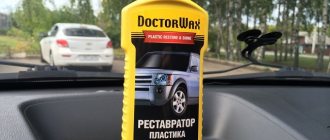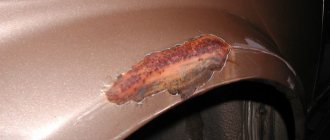Motorists naturally want to keep their car in optimal condition. This applies not only to the technical component, but also to appearance.
Today on the market there is a huge amount of all kinds of chemicals created to protect paintwork. These are ordinary polishes, special wax, etc. Liquid glass is rightly considered one of the modern solutions.
At the same time, not everyone fully understands what it is, for what purposes it is used and how it is applied to various surfaces of the car.
Liquid glass for cars
Any car owner wants it to always look impeccable. Scratches and chips hurt the eye, and painting and polishing a car is expensive, and besides, you can’t polish a car often, since each polish reduces the layer of paintwork.
Liquid glass eliminates minor defects in the paintwork of your car, removes cracks and scratches, and also protects your car from new damage and rust. Also, liquid glass creates a magnificent mirror effect on the car body.
The main advantages of liquid glass:
- Gives the vehicle a rich new car mirror finish
- Protects the car from external influences, ultraviolet radiation
- Has water-repellent and dirt-repellent properties
- Creates an antistatic effect (does not allow static electricity to accumulate on the car body)
- Protects the car body from corrosion
- They have a reasonable price
- Ensures coating durability, up to 6 - 12 months
Polishes and protective compositions “liquid glass” appeared in Russia in 2008 and immediately gained great popularity due to the creation of a wonderful and irresistible effect, the inexpensive cost of materials and a simple method of application.
The name “liquid glass”, which has become a household name in Russia, is erroneous; in fact, the polishes and protective compounds that are sold in our country under this name are not liquid glass. In Japan, these compounds are often called Glass Coat, which can be translated as glass coating.
Liquid glass will help give your car the effect of a new car, sparkling, without a single scratch, deep shade. We are sure that all car enthusiasts want to see their car years later in exactly the same condition. Liquid glass is the product that can return your car to its salon appearance.
In addition to the body, liquid glass is used for headlights, glass, wheels, and various chrome-plated car parts.
TOP 6 best brands of liquid glass manufacturers
HKC Ceramic Coating 2.2
This is a high-quality Estonian professional polish intended for professional use. Best suited for cars with silver paint, adding a prism effect. HKC Ceramic Coating has a soft texture, it is easy to work with, it stretches and polishes well. 50 ml should be enough to treat a huge jeep or 2-3 treatments of a passenger car in 4-5 layers.
HKC Ceramic Coating can withstand up to 80 car washes (approximately 1.5 years of operation), giving the car a pronounced self-cleaning effect. A special feature of this liquid glass is the formation of a particularly durable layer of polish that can protect the car’s paintwork from minor damage, chips and scratches.
Ceramic PRO 9H
This is Taiwanese professional liquid glass, which is best not to apply yourself. It is recommended for distribution among car dealerships and car service centers, and is practically not sold in the public domain. Ceramic PRO 9H requires careful adherence to all the details of body preparation and application of the composition. Violation of strict technology can lead to damage to the factory body coating.
This liquid glass has a lasting effect, withstanding about 100 washes (about two years of operation). To maintain the result longer, it is recommended to renew the top coat every 9-10 months. Looks better on cars of dark colors, adding a “wet effect”. The consumption of Ceramic PRO 9H is quite large: 50 ml will cover a passenger car in just three layers. The cost of this liquid glass is an order of magnitude higher than conventional semi-professional polishes.
Koch Chemie 1K-Nano
Professional liquid glass from a famous German brand, intended for specialized salons and service centers. Koch Chemie 1K-Nano is sold in a 250 ml bottle, complete with instructions, a measuring cup for dosing and a sponge. The coating provides a perfectly glossy surface with reflections and good protection of the body from minor mechanical impacts.
Koch Chemie 1K-Nano has an excellent hydrophobic effect, causing droplets to roll off the surface without leaving streaks. It has excellent resistance to aggressive chemical environments: acids, alkalis, resins, bitumen. The application of this liquid glass, like other professional compositions, requires careful preparation of the body and strict adherence to the instructions.
Soft99 Glass Coating H-7
Inexpensive Japanese one-component semi-professional polish based on silicates. This liquid glass contains petroleum solvents. Soft99 Glass Coating H-7 can be applied both to paintwork and to plastic, chrome and metal parts, but care must be taken not to get it on rubber, as it destroys its composition.
Soft99 Glass Coating H-7, when applied to a car, provides more of a protective effect than a decorative one. This liquid glass forms a dense, durable, thick coating, protecting the paint layer quite well from scratches and chips, but does not provide ideal gloss. To treat a passenger car in several layers, about 50 ml of the composition will be required. The hydrophobic effect lasts less than six months, the protective effect lasts longer - approximately 7-9 months.
Willson Body Glass Guard
Liquid glass from a Japanese manufacturer based on silicates, which is very popular. It creates a fairly thick, durable coating on the surface of the machine. Willson Body Glass Guard consists of two components: the polish itself and the activator, which must be mixed in equal quantities immediately before application. The finished solution can retain its properties for several days, after which silicon precipitates and liquid glass loses its functions.
Willson Body Glass Guard is an inexpensive option for covering your car yourself. One bottle is enough for one treatment of a standard car in several layers. It comes in dark and light shades. The kit includes a special sponge for applying the solution. The declared effective life of the coating is one year; in fact, this liquid glass can withstand no more than 40-50 washes (6-8 months).
Gyeon Q2 Prime
This is semi-professional liquid glass made in Korea. Contains 50% silicon dioxide and works in conjunction with Q2 Cure shine activator. It has high chemical resistance, when applied, it fills and masks cracks and scratches well, and forms a smooth, glossy surface. This liquid glass looks especially good on black and metallic cars.
Gyeon Q2 Prime retains its qualities for about 8-9 months (about 50-60 washes) instead of the declared one, after which the coating must be renewed. This liquid glass has poor resistance to car shampoos with an acidic environment. Rain leaves stains in the form of drops on the car. This polish can be purchased if you plan to cover the car yourself, since you will have to pay 8-10 thousand for work at a car service center, and in less than a year you will again need to shell out the same amount.
Types of liquid glass
Liquid glass in Russia is sold in several versions. The first is small containers of 100-200 ml. with liquid and a sprayer, which is usually included. This polish must be sprayed onto the surface of the car body, and then wait until it dries.
The second option is “liquid glass” polishes in the form of pastes, usually in tubes of up to 100 ml. These polishes are sold complete with a sponge for application and towels for polishing the car.
Also note that liquid glass compositions are often divided into polishes for light and dark cars.
Do-it-yourself coating of the body with liquid glass
What you will need to complete the application:
- A large sponge that will be used for washing.
- Car shampoo.
- Surface degreasing agent.
- Microfiber cloth.
- Liquid glass.
Before polishing you must:
- Wash the car
- Remove reagent
- Remove bitumen
- Remove traces of insects
- Touch up chips
- Degrease the body
Washing and degreasing the body
The procedure begins with cleaning the body. Wash the car using shampoo and sponge, dry well. Then use a degreaser to ensure the best adhesion. For degreasing, you can use white spirit or any universal degreaser, the price of which is only 100 - 200 rubles. In auto stores and supermarkets you can find inexpensive degreasers from Runway or Hi-Gear.
Using a soft sponge, treat the entire car body with degreaser, after which you need to wash off all the degreaser from the body under water pressure. A Karcher car wash is suitable for this, or you can use the nearest manual car wash. There is no need to use shampoo, just good water pressure.
The next stage is coating with liquid glass; for this we mix the two compositions that come with the liquid glass and shake the can thoroughly to thoroughly mix the compositions.
Next, take a special cloth from the liquid glass kit and spray the composition on it and on the car body. After that, apply the composition to the surface with smooth movements.
Thus, with smooth movements, we process every detail of the car.
At least 45 minutes must pass for the composition to interact with the paintwork of the car.
Liquid glass can be applied to chrome and plastic parts of the car body, as well as to all car windows, except the windshield.
Final polishing of liquid glass
After applying liquid glass to the car body and at least 45 minutes have passed, it is necessary to finally polish the applied liquid glass using a microfiber cloth.
When you have completed the application and polishing work, leave the vehicle to dry for at least 6 hours, during which time the vehicle should not be driven. It may take 1-2 weeks for the composition to completely harden; during this period it is not recommended to wash the car.
Some tips:
- It is better to check how liquid glass reacts with the surface when applying. If the result does not satisfy you, then you need to re-wash the car and degrease the body again.
- There is no need to rush too much when rubbing, but delay is also unacceptable. Partial hardening occurs within a few minutes.
- It is recommended to carry out work indoors, for example in a garage.
How to apply liquid glass to your car yourself
If you plan to cover your car with liquid glass yourself, then it is better to choose a semi-professional polish, it is much easier to work with. A professional one will do you a disservice, since to work it requires certain skills and certain conditions that are difficult to create in a regular garage, you will also need an infrared lamp for drying. The likelihood that when working with professional polish you will make mistakes, including damage to the paintwork, is very high.
Liquid glass polish can be dark or light; you should choose the one that best matches the color of the car.
1. First you need to prepare all the necessary materials and equipment: the polish itself, impregnation, pipettes, napkins and sponges, protective gloves. If the liquid glass is two-component, then check for the presence of an activator.
2. Next, you need to prepare the room where the procedure will be carried out. You cannot work outdoors, as you will be disturbed by the sun, wind, dust, dirt, rain, and insects. The room where you plan to work should be:
- closed from external atmospheric factors,
- temperature above 15ºС,
- humidity no more than 50%,
- with bright lighting so as not to miss dirt and defects,
- equipped with ventilation with a filter that prevents the absorption of street dust.
3. Wash and dry the car thoroughly.
4. Wipe off all old heavy stains with a special cleaner.
5. Remove the previous polish, if any.
6. Wipe the car with a degreaser, you can use white spirit. The machine must be completely dry before applying liquid glass.
7. Protect plastic elements and windows so that polish does not get on them.
8. You can begin applying the first layer of polish, treating each part separately. Start with the most easily accessible places to practice. You can apply the polish with a sponge or soft, lint-free cloth. The first layer is preparatory. Next comes the main stage of work - mirror polishing. It should be applied in at least two layers. Apply liquid glass in a circular motion in small areas so that it does not have time to dry out.
9. In total, you need to apply at least 4 layers. The more layers you apply, the better and more durable the coating will be. Each layer must dry for at least one and a half hours for a high-quality coating.
10. After applying the last layer, you can walk over the surface with a clean napkin to remove whitish deposits.
11. After completing the work, you must leave the car until the liquid glass dries completely. Depending on the ambient temperature, the drying process may take from 6 to 12 hours. Until the liquid glass is completely dry, you cannot drive the car. Complete polymerization of the coating occurs in one and a half to two weeks. But during this time you can already drive the car, but you should not wash it yet, especially with aggressive detergents.
Preparing, processing the car and applying polish is a very long and labor-intensive process. The first processing will take a lot of time and effort, but with the acquisition of skills, next time you can do it in 5-6 hours.
Liquid glass can be applied not only manually, but also using a special grinding machine for cars with a soft nozzle. This will significantly reduce the polish application time. If it is not possible to purchase a grinder, then you can use a regular drill with soft attachments.
If you did everything correctly, liquid glass will give your car a beautiful look and will protect its coating for a year, after which the procedure can be repeated.
Liquid glass, before and after
We have collected several examples of processing a car body with liquid glass.
Preparation for application
Before processing, the car should be properly prepared, namely:
- clean well from dirt;
- wash thoroughly;
- degrease and dry.
If it has already been coated with polish, it must be removed. Low-quality alcohols or compounds containing silicone are unsuitable for body preparation.
It is very important that there is no intermediate layer between the paint coating and the applied liquid glass, which can impair adhesion.
The temperature when performing work should be in the range from +10 °C to +40 °C. Therefore, if work is carried out in winter, the garage must be heated. It is not allowed to apply liquid glass to heated surfaces, so the car should not be left in the sun for a long time before doing this. In practice, complete body treatment takes from 3 to 4 hours.
Composition of liquid glass
Liquid glass is also called nanoceramics. Let's figure out what is included in its composition.
- Titanium oxide three percent. Titanium is a chemical that protects thermoregulation. In this composition, liquid glass is protected from high temperatures and has the property of bleaching;
- Silicon dioxide is present in liquid glass at thirty percent. It forms the basis of the coating and gives hardness and strength to the product;
- Aluminum oxide content is slightly less than two percent. It gives the material fire-resistant properties;
- Surfactants (surfactants). They are used to “push” dirt and dust out. Used in most bleaching and cleaning products, also in liquid glass;
- Decamethylcyclopentasiloxane. Contained in fifty percent of the entire product and provides oxidation resistance. It is considered fundamental in the “construction” of the base solution;
Useful tips for preparing hydrous silicate:
- An aqueous silicate solution has become an excellent solution for protecting against dampness in basements and wells. For 1 kg of hydrous silicate, take 10 kg of concrete; the walls of basements and wells are treated with this composition.
- It is recommended to thoroughly stir the aqueous silicate composition with a brush or roller. The proportions of the components should be determined only after you have determined the purpose of using such a solution.
- If silicate is used as an additive in cement, be sure to stir the mixture constantly. After using the composition, wash your hands thoroughly in soapy water.
- If hydrous silicate gets on your skin, it is recommended to immediately treat the contaminated area with running water.
- If you decide to treat the walls with the composition, you will first have to level them and degrease them. To apply the substance, use a regular brush and spray gun. If you decide to make a more thorough and thick coating, apply several layers of the solution.
Important! Regardless of how you use hydrous silicate - in combination with other substances or on its own, always take precautions. Wear protective gloves, a mask and, if possible, special glasses.
Cost of coating with liquid glass
The cost of liquid glass itself usually does not exceed five thousand rubles per jar, depending on the brand and size. As a rule, in Russia jars are sold in sizes up to 300 ml. facilities. On average, one car requires from forty milliliters. So this tube will be enough for you to apply several times.
The cost of the most popular set of liquid glass in Russia - willson glass guard - usually does not exceed 3,000 rubles.
The cost of coating with liquid glass in car dealerships and workshops averages 4 - 8 thousand rubles. Below we present prices for car coverage in several workshops in Moscow.
Manufacturers and cost
Liquid glass for cars is produced by many manufacturers.
Of course, such a promising market as liquid glass for car bodies is attractive to a large number of manufacturers. Among them are representatives of different countries and price categories: V-MAFA (China), KillAqua (Russia), GYEON and CQuartz (South Korea), Nanoskin (USA) and Willson (Japan). Also, when listing brands of polishes and liquid glass for cars, it is certainly worth remembering Everglass - a professional-grade ceramic coating, unfortunately, available for application only in auto centers. When choosing liquid glass for a car, which one is better is a controversial issue. Here you should take into account the ratio of cost, duration of action, resistance to detergents, ease of application, layer strength and water-repellent properties. So, each brand has its own characteristics. For example, liquid glass for cars Willson glass guard , which is based on silicon dioxide, when applied to the body, can provide protection for at least a year, with an average price of $60. By the way, this line has separate products for dark and light cars, which allows you to restore the brightness of the original body color as much as possible.
Liquid glass is produced by many manufacturers of protective chemicals for cars. You can always find something suitable
The Korean brand CQuartz also uses silicon dioxide and can withstand up to fifty washes. The price range starts from $50, but the main advantage of this product is the adaptation of the product to our climatic conditions. Its sister brand, GYEON, lasts for eighty washes. At the same time, when assessing the antistatic properties of this liquid glass for cars, reviews from owners indicate that the intervals between washes are significantly increased. In turn, the domestic KillAqua offers protection from six months to three years, with an average cost of $80. But there are very controversial reviews regarding this brand. So, for some, the price for real quality is too high, while others do not notice a positive effect at all.
Liquid glass willson body glass guard
Liquid glass from Willson has established itself among car enthusiasts as one of the highest quality and inexpensive coatings. The cost of the set is only 3000 rubles.
In addition to the mirror surface, the manufacturer claims protection from minor scratches and ultraviolet radiation, and also has a water-repellent base and protects against fading. Willson guarantees the effect of the composition for 1 year or 50 contactless washes.
Body Glass Guard is available for light and dark cars. These compositions are completely transparent and differ only in thermal additives, since dark shades heat up more strongly in the sun.
The Willson Body Glass Guard kit includes a sponge for applying the compound, two towels for polishing and a plastic glove to protect the skin of your hands.
Instructions for use Willson Glass Guard:
Catalog numbers:
Polish for light cars - WS-01238 (70 ml), WS-01237 (110 ml), WS-01236 (140 ml) Polish for dark cars - WS-01241 (70 ml), WS-01240 (110 ml), WS- 01239 (140 ml)
You can order polish using catalog numbers in popular online auto parts stores exist.ru, autodoc.ru, emex.ru
The official website of the polish manufacturer is willson-eng.com
Japanese innovation
The development of a unique composition began in Japan, where they first began to coat cars with the product. Compared to standard polishes with wax, silicone and other polymers, liquid glass creates a more noticeable shine, effective protection and stays on the car for a long time.
Today, Japan remains a leader in the field of products for protecting the body from an aggressive external environment. The most popular brand is Wilson. The product of this manufacturer is a standard of quality due to a number of positive characteristics:
- increased strength of the composition;
- greatest durability;
Liquid glass Willson Body Glass Guard
- improved ability to repel dirt and water;
- does not include abrasive characteristics;
- creates a mirror effect;
- retains its original appearance.
Any car owner can apply the product, since there are no restrictions on the use of the composition.
Advantages and disadvantages
Main advantages:
- Liquid glass perfectly protects the paintwork and copes with the assigned tasks.
- Gives a nice mirror-like appearance to the car.
- Unlike wax treatment, liquid glass retains its properties for up to 1 - 2 years.
- You can apply the composition not only to the body, but also to chrome and plastic elements of the car and even glass. (except windshield)
- It’s easy to treat your car, just follow simple recommendations.
The disadvantages include:
- Liquid glass is a protective agent and cannot remove the dullness and scratches of the old paintwork. To do this, it is recommended to do an abrasive polish before covering the car with liquid glass to remove dullness and scratches.
Pros and cons of car processing
pros
- Bright shine providing the effect of newness of color.
- The protective film lasts for a long time (6-8 months).
- Resistant to temperature changes.
- Repels water and dirt.
- The surface is harder than other polishes.
- It is enough to wash the car with water. Chemical car shampoos are not recommended, at least in the first months after polishing.
Minuses
Despite all the advantages of the procedure, there are a number of disadvantages. Among them:
- Treatment in a salon will cost a pretty penny.
- It is quite difficult to carry out the procedure yourself. This is because the liquid crystallizes quickly. Sufficient skill and skill is required.
So, you have weighed all the pros and cons of liquid glass for a car. Let us warn you once again, covering a car with liquid glass is a complicated procedure. In case of a small mistake, the result can be disastrous. If you are sure that you have sufficient skills to handle a car yourself, go ahead!
